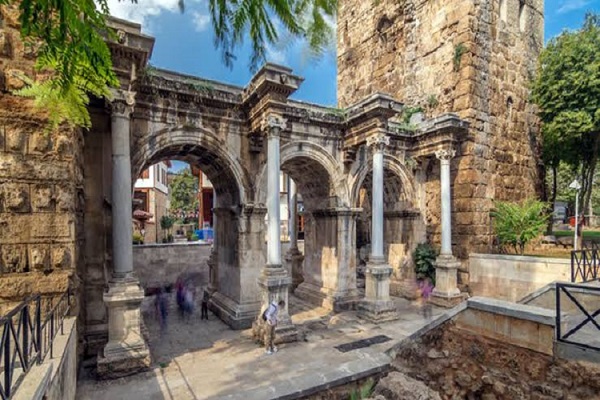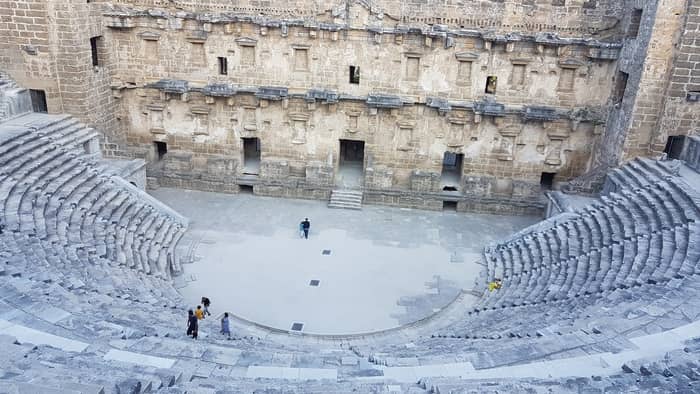
Historical Sites in the Antalya Area
With its long and colourful history, the Antalya region is rich with archaeological sites that enable us to get a glimpse into civilizations past. We can wander the remains of streets, buildings, temples and amphitheatres and let our imagination do the rest. Armed with a little knowledge, or at least Google on your phone, you can explore at your heart’s content and be captivated by the history of those who settled in the region and established the first towns and cities. History lovers are in the best place to explore their interests but, even if you are not a real history buff, you can’t help but be in awe of the splendor of the sites and have your curiosity stirred.
Originally known as Attalia, Antalya was founded during the Hellenistic period. From that time it came under Roman, Byzantine, Selcuk and Ottoman rule. Today, of course, it is one of the world’s leading tourist destinations, not only for the warmth of the Mediterrranean summer, but also for its rich history. And, if the city of Antalya is the base for your holiday, your first glimpse into its famous history is likely to be in the Old Town, known in Turkish as Kaleici.

Kaleici is famous for its shopping, cafes, restaurants, bars and spectacular views of the Mediterranean and mountains in the distance. But, beyond that, it is full of the history of the people that established, inhabitated, conquered and developed it. As an impressive entrance to Kaleici, Hadrian’s Gate does not disappoint. Named after the Roman Emporer Hadrian, it was built to commemorate his visit in AD130. Once you’ve pondered in amazement at its construction and admired its intricate stonework, step across the giant marble slabs, worn smooth by the footsteps of civilizations that passed before you, and wander at leisure along the cobbled streets to see the beautifully restored, stone Ottoman houses which are now boutique hotels and restaurants. Within Kaleici there are a number of historical landmarks to see such as the Mehemet Pasa Cami (mosque), built in the 18th century and the Kesik Minare Cami (broken minaret mosque), which apparently the council has deemed it should be restored. Many argue that it should be left as it is, as even its demise is part of its history.

Fifty kilometres to the East of Antalya is the ancient site of Aspendos, which is famous for having one of the world’s best preserved ancient amphitheatres. Aspendos was probably one of the most important cities in the region of Antalya as it had an harbour and an abundance of oil, wool and salt to trade amongst other goods. The famous amphitheatre was built in 155AD, as a present to the Emperor, Marcus Aurelius. With the capacity to seat 15,000 people, these days it hosts the annual Aspendos Opera and Ballet Festival. It’s an amazing venue and experiencing a performance there will give you goosebumps as you get carried away with the atmosphere, admire the natural accoustics and imagine who may have sat in the exact same place as you over the centuries. Aside from the splendour of the amphitheatre, there is the basilica, agora (market place), nymphaeum (shrine), a bouleuterion(council chamber) and a Roman aqueduct which supplied Aspendos with its water to sea. When visiting Antalya, even if it is not the Opera and Ballet season, check online, as there is often a wonderful variety of performances to be enjoyed throughout the year, particularly the summer season of course.

Close to the city of Antalya, just 35km away, is another historical site that should definitely be on your list of places of interest, and that is the ancient city of Termessos. Termessos is located high in the Taurus Mountains and reaching the site is half the experience. The journey is picturesque and you can either take a tour to the site or drive yourself, enjoying the scenery along the way. As the site is at an altitude of 1000m, once you reach the amphitheatre, the view is spectacular. Termessos is considered to be one of the most ideally located sites in all of Turkey, and one can only imagine that its location must have kept it relatively safe from invasion. In fact, this proved to be the case, as Alexander The Great attempted to conquer the area in around 334BC, but failed. Termessos became a very prosperous town during the Hellenistic period but, it appears the heirs of Alexander The Great were deteremined to succeed where Alexander had failed, and they continued with attempts to conquer the area. According to the legend, however, it was a Greek hero who rode the winged horse, Pegasus, that supposedly had more success than Alexander The Great or anyone else in their attempts at conquering by throwing stones at the residents and sending them fleeing into the mountains. Being that was just a legend, the people of Termessos continued to thrive in their mountainous location and even under Roman rule, they were able to remain quite separate from the State, making their own laws and even minting their own coins. Finally, it was Mother Nature that caused the demise of Termessos, when an earthquake destroyed the aqueduct that supplied drinking water to the city, however it is not known exactly when this occurred. As well as the amphitheatre, you’ll find remains of other ancient buildings in amongst the pines including an agora, gymnasium, city walls, necropolis(cemetery) and water cisterns.

Like Termessos, the ancient site of Olympos, situated approx. 70 km from the city of Antalya, is in a rather fairytale-like setting, with ruins hidden amongst beautiful pines and the sound of babbling brooks making their way to the river running through the ancient city. Olympos was an important member of the Lycian League, a collection of powerful cities that ruled the Southwest coast. Its history sees it as Lycian, invaded by pirates and numerous other times under Roman rule and finally added to the Ottoman Empire in the 15th century. Until quite recently, it had been inhabited by nomads but it is now a popular tourist destination with both foreigners and Turkish people. Summer sees the area swarming with visitors who come not only for the historical aspect, but also to enjoy the natural environment.
Olympos is right on the beach, and has pine covered mountains to three sides. İt is an absolute delight for nature lovers and fortunately, laws prohibit any large scale tourism development. Simple accomodation can be found nearby, most often in the form of tree house type dwellings or, for a more luxurious options, wooden huts. The site itself is within a natural open museum site, so an entrance fee is required. Also, this is the only access to the beach from Olympos so enjoy the site, even if your goal is the beach. But a word of warning, avoid visiting on Turkish public holidays unless you like crowds. While there, be sure to visit the burning rocks of Chimera. It’s a bit of a hike and definitely best seen at night. Fun to take a bottle of wine, cheese and crackers and marshmallows to toast. And naturally, take all rubbish back with you.
These are just a few of the wonderful sites that can be enjoyed in the region. With a few more days to spend, there are many more just waiting to be explored.
